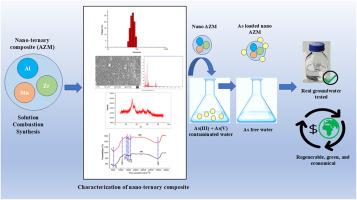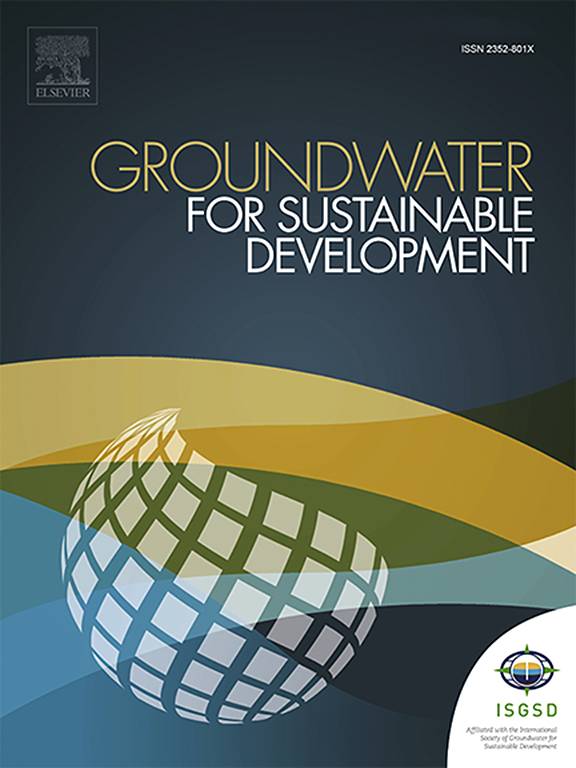High-performance nano-ternary composite (Al-Zr-Mn) for enhanced arsenite removal from groundwater: Insights into adsorption dynamics and sustainability analysis
IF 4.9
Q2 ENGINEERING, ENVIRONMENTAL
引用次数: 0
Abstract
The global concern over arsenic contamination is intensified by the co-existence of both arsenic species, As(III) and As(V), making the groundwater treatment challenging. Thus, the present study aimed to address both arsenic species using a trimetal-based nano ternary adsorbent. The material was synthesized by the combustion method, with conditions optimized to maximize removal performance. The relative composition of the trimetal Al, Zr, and Mn (AZM) was varied to obtain a zero-point charge (pHzpc) value > 7. The nano-AZM prepared was also characterized for its morphological and surface characteristics. Performance testing revealed a notably higher removal efficiency for As(III) than for As(V), with only 18 mg of the nano-AZM composite reducing As(III) concentration from 750 ppb to below 10 ppb. Moreover, sequential extraction results revealed distinct interaction mechanisms and molecular speciation patterns responsible for this enhanced uptake. In-depth analysis of adsorption underscores the substitution of –OH group on nAZM surfaces by arsenic ions. The adsorption behavior was well represented by the Freundlich isotherm model, while the kinetics followed a pseudo-second order model. The material also demonstrated strong reusability and maintained high removal efficiency in real groundwater samples. Moreover, Life Cycle Assessment (LCA) and cost evaluation further highlighted the environmental and economic viability of the nano AZM-based treatment system.

高性能纳米三元复合材料(Al-Zr-Mn)用于增强地下水中亚砷的去除:对吸附动力学和可持续性分析的见解
砷(III)和砷(V)两种砷的共存加剧了全球对砷污染的关注,使地下水处理具有挑战性。因此,本研究旨在利用三金属基纳米三元吸附剂来处理这两种砷。采用燃烧法合成了该材料,并优化了条件以获得最佳的去除性能。改变三金属Al, Zr和Mn (AZM)的相对组成以获得零点电荷(pHzpc)值>; 7。对制备的纳米azm进行了形貌和表面表征。性能测试显示,As(III)的去除效率明显高于As(V),仅18 mg纳米azm复合材料就能将As(III)浓度从750 ppb降至10 ppb以下。此外,序列提取结果揭示了不同的相互作用机制和分子物种形成模式负责这种增强的吸收。深入的吸附分析强调了-OH基团在nAZM表面被砷离子取代。吸附行为可以用Freundlich等温模型很好地表示,而吸附动力学则符合准二阶模型。该材料在实际地下水样品中也表现出较强的可重复使用性,并保持了较高的去除效率。此外,生命周期评估(LCA)和成本评估进一步强调了纳米azm处理系统的环境和经济可行性。
本文章由计算机程序翻译,如有差异,请以英文原文为准。
求助全文
约1分钟内获得全文
求助全文
来源期刊

Groundwater for Sustainable Development
Social Sciences-Geography, Planning and Development
CiteScore
11.50
自引率
10.20%
发文量
152
期刊介绍:
Groundwater for Sustainable Development is directed to different stakeholders and professionals, including government and non-governmental organizations, international funding agencies, universities, public water institutions, public health and other public/private sector professionals, and other relevant institutions. It is aimed at professionals, academics and students in the fields of disciplines such as: groundwater and its connection to surface hydrology and environment, soil sciences, engineering, ecology, microbiology, atmospheric sciences, analytical chemistry, hydro-engineering, water technology, environmental ethics, economics, public health, policy, as well as social sciences, legal disciplines, or any other area connected with water issues. The objectives of this journal are to facilitate: • The improvement of effective and sustainable management of water resources across the globe. • The improvement of human access to groundwater resources in adequate quantity and good quality. • The meeting of the increasing demand for drinking and irrigation water needed for food security to contribute to a social and economically sound human development. • The creation of a global inter- and multidisciplinary platform and forum to improve our understanding of groundwater resources and to advocate their effective and sustainable management and protection against contamination. • Interdisciplinary information exchange and to stimulate scientific research in the fields of groundwater related sciences and social and health sciences required to achieve the United Nations Millennium Development Goals for sustainable development.
 求助内容:
求助内容: 应助结果提醒方式:
应助结果提醒方式:


